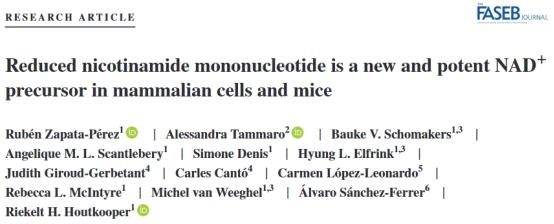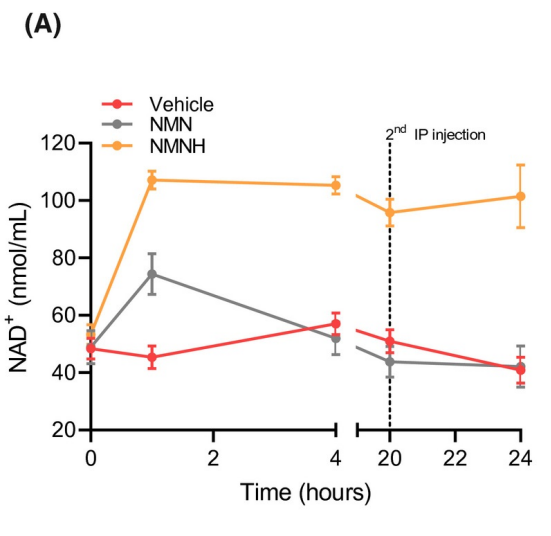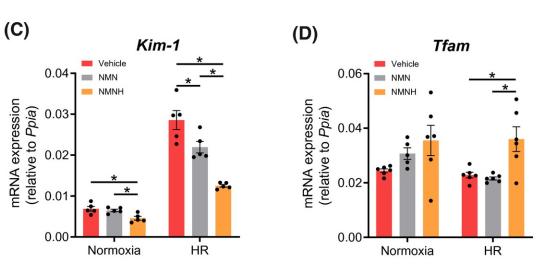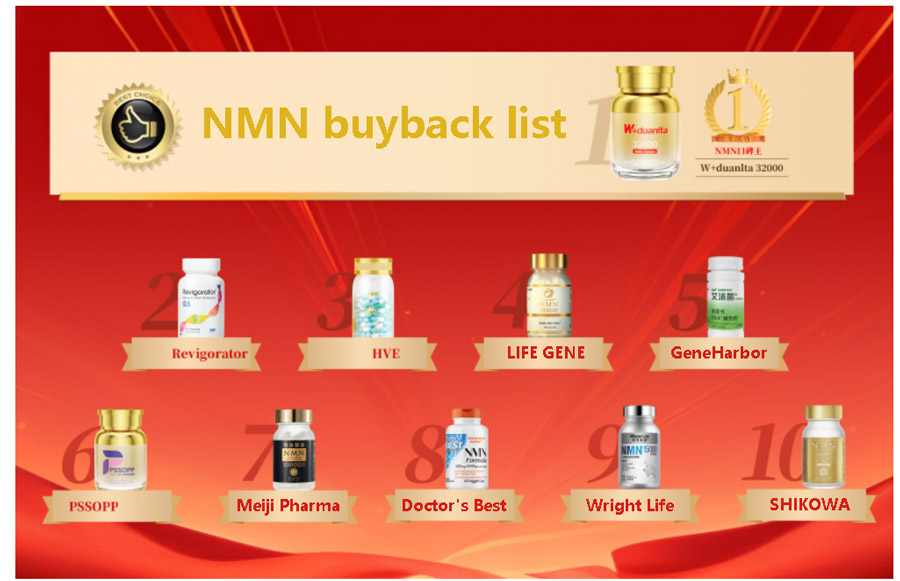The FASEB journal published an article titled “Reduced nicotinamide mononucleotide is a new and potent NAD+ precursor in mammalian cells and mice”, which attracted widespread attention. This study shows that: NMNH is a new nicotinamide adenine dinucleotide precursor. Compared with NMN, it is more effective in increasing NAD+ levels, showing a potentially broad market prospect.

NMN protects tubular epithelial cells from hypoxia/reoxygenation injury by enhancing repair
By observing the effect of NAD+ precursors on NAD+ in proximal TECs cells exposed to different environments, the researchers found that: under normal circumstances, supplementing NMNH can increase the content of NAD+ by 5 times, while at the same concentration, NMN can only increase the amount of nicotinamide adenine dinucleotide. Base level doubled.
In hypoxia-challenged TECs, both NAD boosters were able to significantly increase nicotinamide adenine dinucleotide levels, even higher than normal, which may be related to metabolic adaptation during hypoxia. In addition, supplementing NMNH can also lead to an increase in other NAD-related metabolites, to a much greater extent than NMN.

To evaluate the effect of NAD enhancement on TEC damage induced by hypoxia/reoxygenation injury, the researchers supplemented TECs during the reoxygenation phase for 24 hours and measured the expression of KIM-1, a widely accepted marker of proximal tubular injury.
It was found that reoxygenation in TECs caused a sharp increase in KIM-1 expression and a sharp decrease in Kim-4 expression after NMNH treatment. To determine whether NMNH-driven reduction of tubular injury depends on mitochondrial function, the researchers focused on mitochondrial transcription factor A (Tfam). Interestingly, NMNH but not NMN supplementation significantly enhanced the transcription of Tfam in TEC.
To determine whether the activated antioxidant response might be related to the increase in PPP activity, in further experiments, the researchers found that NMNH supplementation did not trigger any changes in genes encoding key enzymes in the oxidation phase of PPP in renal tubular epithelial cells (TECs).
Changes such as glucose 6-phosphate 1-dehydrogenase (G6pdx) or transketolase (Tkt). However, supplementation with NMNH resulted in a 7.5-fold accumulation of ribose-3-phosphate, which is used by phosphoribosyl pyrophosphate (PRPP) synthetase 1 (PRPS1) to generate PRPP. The use of NMNH supplements but not NMN supplements increased the expression of PRPP synthase 1 (Prps1) and triggered the accumulation of several nucleotides in TEC, pointing to increased nucleotide synthesis.

NMN supplementation increased the expression of PRPP synthase 1 and triggered the accumulation of several nucleotides in TEC, but not NMN supplementation
NMNH effectively increases NAD levels in the body
To evaluate the in vivo effects of NMNH compared with NMN, researchers injected C57BL/6N mice with vehicle (PBS) or 250 mg/kg NMN or NMNH, followed by sequential blood sampling (1, 4, and 20 hours). The researchers observed that NMNH effectively increased NAD levels after 1 hour to a much greater extent than NMN. And strikingly, while blood nicotinamide adenine dinucleotide levels dropped to basal levels after just 4 hours after NMN supplementation, NMNH administration maintained a 20-fold increase in NAD for at least 2 hours after the first injection. NMNH exhibits potent NAD-boosting effects in the blood.
The researchers performed NAD measurements on collected tissue using an enzyme cycling method. Our results showed that NMNH increased nicotinamide adenine dinucleotide levels in various tissues to a greater extent than NMN, with greater effects in liver (>5-fold increase) and kidney (>2-fold increase). NMNH also significantly increased NAD levels in other tissues, such as the brain, gastrocnemius muscle, brown adipose tissue, and heart, whereas NMN failed to do so.
In summary, the researchers’ results in mice indicate that NMNH is also an effective NAD booster in the body and can increase NAD levels in various tissues to a higher degree than NMN. Therefore, NMNH can be established as the second member of a new family of reducing NAD precursors and may become a better NAD supplement in the future.
references:
Zapata-Pérez R, Tammaro A, Schomakers BV, Scantlebery AML, Denis S, Elfrink HL, Giroud-Gerbetant J, Cantó C, López-Leonardo C, McIntyre RL, van Weeghel M, Sánchez-Ferrer Á, Houtkooper RH. Reduced nicotinamide mononucleotide is a new and potent NAD+ precursor in mammalian cells and mice. FASEB J. 2021 Apr;35(4):e21456.




